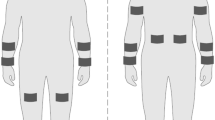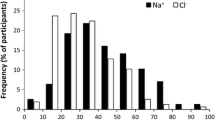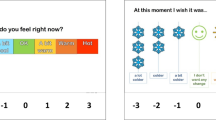Abstract
Purpose
It is recently reported that determining sweat rate (SR) threshold for increasing galvanic skin conductance (GSC) would represent a maximum rate of sweat ion reabsorption in sweat glands. We evaluate the maximum rate of sweat ion reabsorption over skin regions, sex, and long-term exercise training by using the threshold analysis in the present study.
Methods
Ten males (2 untrained, 4 sprinters, and 4 distance runners) and 12 females (5 untrained, 4 sprinters, and 3 distance runners) conducted graded cycling exercise for 45 min at low, middle, and high exercise intensities (heart rate 100–110, 120–130, and 140–150 beats/min, respectively) for 10, 15, and 20 min, respectively, at 30 °C and 50% relative humidity. Comparisons were made between males and females and among untrained individuals, distance runners, and sprinters on the back and forearm.
Results
SR threshold for increasing GSC on back was significantly higher than that of forearm (P < 0.05) without any sex differences (back 0.70 ± 0.08 and 0.61 ± 0.04, forearm 0.40 ± 0.05 and 0.45 ± 0.06 mg/cm2/min for males and females, respectively). Distance runners and sprinters showed higher SR threshold for increasing GSC than that of untrained subjects on back (P < 0.05) but not on forearm (back 0.45 ± 0.06, 0.83 ± 0.06, and 0.70 ± 0.04, forearm 0.33 ± 0.04, 0.49 ± 0.02, and 0.39 ± 0.07 mg/cm2/min for untrained subjects, distance runners, and sprinters, respectively).
Conclusion
These results suggest that the maximum sweat ion reabsorption rate on the back is higher than that of forearm without sex differences. Furthermore, exercise training in distance runners and sprinters improves the maximum sweat ion reabsorption rate on the back.






Similar content being viewed by others
Abbreviations
- ANOVA:
-
Analysis of variance
- GSC:
-
Galvanic skin conductance
- HR:
-
Heart rate
- \(\dot{V}{\text{O}}_{2\hbox{max} }\) :
-
Maximal oxygen uptake
- T b :
-
Mean body temperature
- \(\bar{T}_{\text{sk}}\) :
-
Mean skin temperature
- RPE:
-
Rating of perceived exertion
- T re :
-
Rectal temperature
- T sk :
-
Skin temperature
- SEM:
-
Standard error of the mean
- SR:
-
Sweat rate
References
Allan JR, Wilson CG (1971) Influence of acclimatization on sweat sodium concentration. J Appl Physiol 30(5):708–712
Amano T, Koga S, Inoue Y, Nishiyasu T, Kondo N (2013) Characteristics of sweating responses and peripheral sweat gland function during passive heating in sprinters. Eur J Appl Physiol 113(8):2067–2075. doi:10.1007/s00421-013-2641-8
Amano T, Gerrett N, Inoue Y, Nishiyasu T, Havenith G, Kondo N (2016) Determination of the maximum rate of eccrine sweat glands’ ion reabsorption using the galvanic skin conductance to local sweat rate relationship. Eur J Appl Physiol 116(2):281–290
American Colledge of Sports Medicine (1995) ACSM's guidelines for exercise testing and prescription. Williams & Wilkins, Baltimore
Araki T, Matsushita K, Umeno K, Tsujino A, Toda Y (1981) Effect of physical training on exercise-induced sweating in women. J Appl Physiol 51(6):1526–1532
Borg GA (1982) Psychophysical bases of perceived exertion. Med Sci Sports Exerc 14(5):377–381
Brown MB, Haack KK, Pollack BP, Millard-Stafford M, McCarty NA (2011) Low abundance of sweat duct Cl- channel CFTR in both healthy and cystic fibrosis athletes with exceptionally salty sweat during exercise. Am J Physiol Regul Integr Comp Physiol 300(3):R605–R615. doi:10.1152/ajpregu.00660.2010
Bulmer MG, Forwell GD (1956) The concentration of sodium in thermal sweat. J Physiol 132(1):115–122
Buono MJ, Ball KD, Kolkhorst FW (2007) Sodium ion concentration vs. sweat rate relationship in humans. J Appl Physiol 103(3):990–994. doi:10.1152/japplphysiol.00015.2007
Buono MJ, Claros R, Deboer T, Wong J (2008) Na+ secretion rate increases proportionally more than the Na+ reabsorption rate with increases in sweat rate. J Appl Physiol 105(4):1044–1048. doi:10.1152/japplphysiol.90503.2008
Cheuvront SN, Bearden SE, Kenefick RW, Ely BR, Degroot DW, Sawka MN, Montain SJ (2009) A simple and valid method to determine thermoregulatory sweating threshold and sensitivity. J Appl Physiol 107(1):69–75. doi:10.1152/japplphysiol.00250.2009
Darrow CW (1964) The rationale for treating the change in galvanic skin response as a change in conductance. Psychophysiology 1:31–38
Del Coso J, Lara B, Salinero JJ, Areces F, Ruiz-Vicente D, Gallo-Salazar C, Abian-Vicen J, Cacabelos R (2015) CFTR genotype-related body water and electrolyte balance during a marathon. Scand J Med Sci Sports. doi:10.1111/sms.12542
Eichner ER (2008) Genetic and other determinants of sweat sodium. Curr Sports Med Rep 7(4):S36–S40
Gagnon D, Kenny GP (2012a) Does sex have an independent effect on thermoeffector responses during exercise in the heat? J Physiol 590(Pt 23):5963–5973. doi:10.1113/jphysiol.2012.240739
Gagnon D, Kenny GP (2012b) Sex differences in thermoeffector responses during exercise at fixed requirements for heat loss. J Appl Physiol 113(5):746–757
Gagnon D, Crandall CG, Kenny GP (2013a) Sex differences in postsynaptic sweating and cutaneous vasodilation. J Appl Physiol 114(3):394–401. doi:10.1152/japplphysiol.00877.2012
Gagnon D, Jay O, Kenny GP (2013b) The evaporative requirement for heat balance determines whole-body sweat rate during exercise under conditions permitting full evaporation. J Physiol 591(Pt 11):2925–2935. doi:10.1113/jphysiol.2012.248823
Hamouti N, Del Coso J, Ortega JF, Mora-Rodriguez R (2011) Sweat sodium concentration during exercise in the heat in aerobically trained and untrained humans. Eur J Appl Physiol 111(11):2873–2881. doi:10.1007/s00421-011-1911-6
Henane R, Flandrois R, Charbonnier JP (1977) Increase in sweating sensitivity by endurance conditioning in man. J Appl Physiol 43(5):822–828
Ichinose-Kuwahara T, Inoue Y, Iseki Y, Hara S, Ogura Y, Kondo N (2010) Sex differences in the effects of physical training on sweat gland responses during a graded exercise. Exp Physiol 95(10):1026–1032. doi:10.1113/expphysiol.2010.053710
Inoue Y, Nakao M, Ishizashi H, Tsujita J, Araki T (1998) Regional differences in the Na+ reabsorption of sweat glands. Appl Human Sci 17(5):219–221
Inoue Y, Havenith G, Kenney WL, Loomis JL, Buskirk ER (1999) Exercise- and methylcholine-induced sweating responses in older and younger men: effect of heat acclimation and aerobic fitness. Int J Biometeorol 42(4):210–216. doi:10.1007/s004840050107
Inoue Y, Ichinose-Kuwahara T, Funaki C, Ueda H, Tochihara Y, Kondo N (2014) Sex differences in acetylcholine-induced sweating responses due to physical training. J Physiol Anthropol 33(1):13. doi:10.1186/1880-6805-33-13
Jay O, Bain AR, Deren TM, Sacheli M, Cramer MN (2011) Large differences in peak oxygen uptake do not independently alter changes in core temperature and sweating during exercise. Am J Physiol Regul Integr Comp Physiol 301(3):R832–R841. doi:10.1152/ajpregu.00257.2011
Kenefick RW, Cheuvront SN, Elliott LD, Ely BR, Sawka MN (2012) Biological and analytical variation of the human sweating response: implications for study design and analysis. Am J Physiol Regul Integr Comp Physiol 302(2):R252–R258. doi:10.1152/ajpregu.00456.2011
Kenny GP, Jay O (2013) Thermometry, calorimetry, and mean body temperature during heat stress. Compr Physiol 3(4):1689–1719. doi:10.1002/cphy.c130011
Kirby CR, Convertino VA (1986) Plasma aldosterone and sweat sodium concentrations after exercise and heat acclimation. J Appl Physiol 61(3):967–970
Machado-Moreira CA, Taylor NA (2012) Psychological sweating from glabrous and nonglabrous skin surfaces under thermoneutral conditions. Psychophysiology 49(3):369–374. doi:10.1111/j.1469-8986.2011.01309.x
Meyer F, Bar-Or O, MacDougall D, Heigenhauser G (1992) Sweat electrolyte loss during exercise in the heat: effects of gender and maturation. Med Sci Sports Exerc 24(7):776–781
Meyer F, Laitano O, Bar-Or O, McDougall D, Heigenhauser GJ (2007) Effect of age and gender on sweat lactate and ammonia concentrations during exercise in the heat. Braz J Med Biol Res 40(1):135–143
Quinton PM (2007) Cystic fibrosis: lessons from the sweat gland. Physiology (Bethesda) 22:212–225. doi:10.1152/physiol.00041.2006
Roberts MF, Wenger CB, Stolwijk JA, Nadel ER (1977) Skin blood flow and sweating changes following exercise training and heat acclimation. J Appl Physiol 43(1):133–137
Saga K (2002) Structure and function of human sweat glands studied with histochemistry and cytochemistry. Prog Histochem Cytochem 37(4):323–386
Sato K, Dobson RL (1970) Regional and individual variations in the function of the human eccrine sweat gland. J Invest Dermatol 54(6):443–449
Sato K, Kang WH, Saga K, Sato KT (1989) Biology of sweat glands and their disorders. I. Normal sweat gland function. J Am Acad Dermatol 20(4):537–563
Shamsuddin AK, Kuwahara T, Oue A, Nomura C, Koga S, Inoue Y, Kondo N (2005a) Effect of skin temperature on the ion reabsorption capacity of sweat glands during exercise in humans. Eur J Appl Physiol 94(4):442–447. doi:10.1007/s00421-005-1354-z
Shamsuddin AK, Yanagimoto S, Kuwahara T, Zhang Y, Nomura C, Kondo N (2005b) Changes in the index of sweat ion concentration with increasing sweat during passive heat stress in humans. Eur J Appl Physiol 94(3):292–297. doi:10.1007/s00421-005-1314-7
Smith CJ, Havenith G (2011) Body mapping of sweating patterns in male athletes in mild exercise-induced hyperthermia. Eur J Appl Physiol 111(7):1391–1404. doi:10.1007/s00421-010-1744-8
Taylor NA, Machado-Moreira CA (2013) Regional variations in transepidermal water loss, eccrine sweat gland density, sweat secretion rates and electrolyte composition in resting and exercising humans. Extrem Physiol Med 2(1):4. doi:10.1186/2046-7648-2-4
Thomas PE, Korr IM (1957) Relationship between sweat gland activity and electrical resistance of the skin. J Appl Physiol 10(3):505–510
Ueda H, Inoue Y (2013) Improved procedure for estimating time-dependent changes in local sweat rates by measuring local sweat volumes. J Ergon 3(3):121
van den Heuvel AM, van den Wijngaart L, Taylor NA (2007) Absence of a gender affect on the flow-dependent nature of sweat sodium loss. Environ Ergon 12:298–300
Acknowledgements
We thank our volunteers for participating in this study.
Author information
Authors and Affiliations
Contributions
Conception and design of research was undertaken by TA, MH, KK, and YI, data collection and analyses was undertaken by TA, MH, KK, and YI, the manuscript was drafted by TA, NG, HU, NK, and YI, and all authors (TA, MH, KK, NG, HU, NK, and YI) contributed to data interpretation, editing and revision of manuscript, and approved the final version.
Corresponding author
Ethics declarations
Conflict of interest
The authors declare that they have no competing interest.
Grants
This study was supported by a Grant-in-Aid for Scientific Research (No. 23247046, 16H04851) from the Japan Society for the Promotion of Science from the Ministry of Education, Culture, Sports, Science, and Technology of Japan.
Additional information
Communicated by George Havenith.
Rights and permissions
About this article
Cite this article
Amano, T., Hirose, M., Konishi, K. et al. Maximum rate of sweat ions reabsorption during exercise with regional differences, sex, and exercise training. Eur J Appl Physiol 117, 1317–1327 (2017). https://doi.org/10.1007/s00421-017-3619-8
Received:
Accepted:
Published:
Issue Date:
DOI: https://doi.org/10.1007/s00421-017-3619-8




